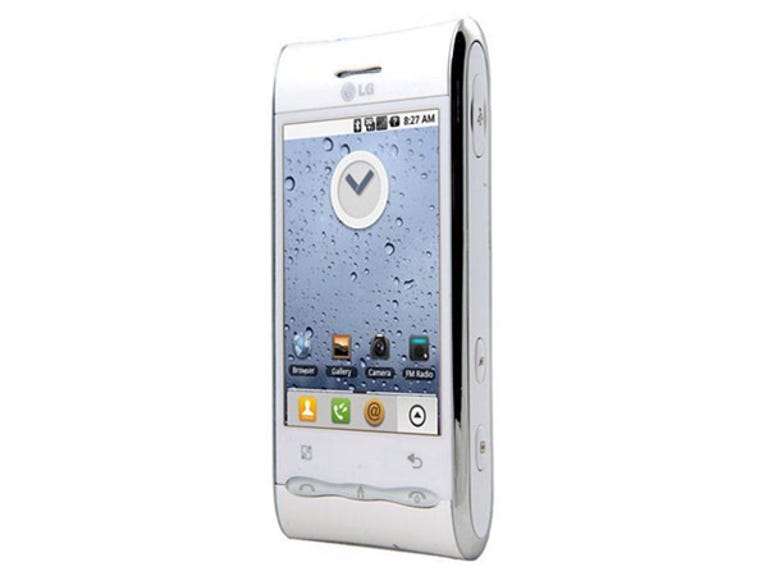 Why You Can Trust CNET
Why You Can Trust CNET LG Optimus review: LG Optimus
LG has cut corners in the wrong places to deliver the Optimus at the right price. Poor performance and frustrating input are always deal-breakers, regardless of price.
Blue steel
We first saw the Optimus back in February at Mobile World Congress when it was called the GT540. At the time we were amazed at how much its tough plastic chassis looks and feels like cool, brushed metal. Even now as we gawk and prod at the Optimus it's hard to believe this is a plastic handset.
The Good
The Bad
The Bottom Line
Sadly, these smoke and mirrors are about the only part of this handset design that we like. The Optimus relies on touchscreen input with the aid of five awkwardly-shaped mechanical keys, which when put together made it a very frustrating experience from an Android handset this year. The touchscreen is especially bad, LG has opted for a resistive screen and has not ended up with a very good one at that. You need to press the screen reasonably firmly to get a response, and even then you may struggle to make the selection you want. One key area that drove us crazy was the difficulty we had dragging down the notifications bar; you basically have to start dragging off the top of the screen to use this feature. We understand this is probably one of the key elements in keeping the price of this phone down, but the sacrifice in usability is unacceptable.
Everything else is pretty much standard, there's a 3.5mm headphone socket on top, volume and camera keys, USB charging port and a microSD card slot under the battery cover. LG has generously included a 2GB memory card with the phone, which is a good start, though media junkies will definitely want to upgrade this to something a bit bigger.
The bare necessities
All in all, this is a pretty bare-bones build of Google's Android. Running on version 1.6 of the operating system, the Optimus features all of the same smartphone tools you'd expect to see on a Google phone, but no real added bonuses to differentiate it from the growing number of other Androids. LG pre-loads a few unique widgets, but nothing worth mentioning in this review.
Email is fully covered by the Optimus, with the option to add webmail, ISP and MS Exchange accounts for business users. There's also a dedicated Gmail app, as there is on all Android devices. Social networking is one area LG attempts something unique, featuring an SNS tool for storing all of your account details and feeding you updates through one central, cleanly-designed message hub.
Multimedia is one area LG phones have excelled in the past, and solid multimedia support would sure do a lot to improve our opinion of the Optimus. Unfortunately, multimedia functionality on this phone seems like an obligation fulfilled by LG, rather than a focus of the company's efforts. Technically, the Optimus is capable of taking photos, watching videos and playing audio, but there's nothing attractive about performing any of these tasks on this phone. The 3-megapixel camera takes washed-out, blurry photos with a strange yellow tinge that confuses its colour reproduction. The Optimus is capable of playing back a range of media files, but the HVGA (320x480) resolution screen is mostly underwhelming when videos play, making all of our stored video files look like crumby streaming video from YouTube.
Slow, not so steady
In the last six months we've seen a vast improvement in the quality of touchscreen phones from the likes of HTC and Samsung. The days of the iPhone being the only touchscreen with really slick, intuitive input are long behind us, except for those who choose the Optimus. In combination with the poor resistive touchscreen used, the Optimus is also underpowered. Though we don't know the specific hardware spec of this phone, the result performance is indicative of a slower processor, and users can expect some sluggish performance, especially after executing several applications. Our advance to Optimus owners is to buy a good task manager off the Android Market and learn how to use it.
Basic calling and messaging are mostly fine, though messaging is made more difficult than it needs to be by an average on-screen keyboard. After using the excellent keyboard on the LG Eve (GW620) we certainly feel the Optimus could use one as well. Call quality was fine during our tests, with the earpiece speaker blasting sound loud and clear, and with good reports from the people we spoke to using this handset.
Overall
We love the idea of cheap Android phones, but we also demand that manufacturers maintain a level of usability while skimping to save money in their designs. LG's decision to employ a lower-resolution resistive touchscreen sacrifices ease of use and it's all downhill from there. The software package is uninspiring and the multimedia functionality feels tacked on. There really is no outstanding feature to recommend this phone by.
Telstra has the Optimus exclusively as part of its Next G range for AU$49 per month on contract over two years. The problem for LG is that Telstra also sells the HTC Desire under identical conditions and it is a vastly better phone. If you find yourself in a Telstra store looking for an Android phone there really is only one choice at this time.


